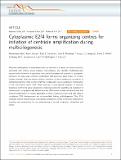Cytoplasmic E2f4 forms organizing centres for initiation of centriole amplification during multiciliogenesis
Author(s)
Mori, Munemasa; Mahoney, John E.; Li, Huijun; Lu, Jining; Zhu, Xueliang; Cardoso, Wellington V.; Hazan, Renin; Miller, Emily Sun Young; Lees, Jacqueline; Danielian, Paul S.; ... Show more Show less
Downloadncomms15857.pdf (2.465Mb)
PUBLISHER_POLICY
Publisher Policy
Article is made available in accordance with the publisher's policy and may be subject to US copyright law. Please refer to the publisher's site for terms of use.
Terms of use
Metadata
Show full item recordAbstract
Abnormal development of multiciliated cells is a hallmark of a variety of human conditions associated with chronic airway diseases, hydrocephalus and infertility. Multiciliogenesis requires both activation of a specialized transcriptional program and assembly of cytoplasmic structures for large-scale centriole amplification that generates basal bodies. It remains unclear, however, what mechanism initiates formation of these multiprotein complexes in epithelial progenitors. Here we show that this is triggered by nucleocytoplasmic translocation of the transcription factor E2f4. After inducing a transcriptional program of centriole biogenesis, E2f4 forms apical cytoplasmic organizing centres for assembly and nucleation of deuterosomes. Using genetically altered mice and E2F4 mutant proteins we demonstrate that centriole amplification is crucially dependent on these organizing centres and that, without cytoplasmic E2f4, deuterosomes are not assembled, halting multiciliogenesis. Thus, E2f4 integrates nuclear and previously unsuspected cytoplasmic events of centriole amplification, providing new perspectives for the understanding of normal ciliogenesis, ciliopathies and cancer.
Date issued
2017-08Department
Koch Institute for Integrative Cancer Research at MITJournal
Nature Communications
Publisher
Nature Publishing Group
Citation
Mori, Munemasa et al. “Cytoplasmic E2f4 Forms Organizing Centres for Initiation of Centriole Amplification During Multiciliogenesis.” Nature Communications 8 (July 2017): 15857 © 2017 The Author(s)
Version: Final published version
ISSN
2041-1723